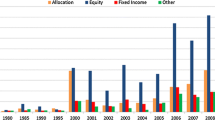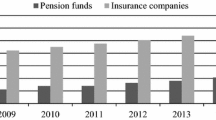Abstract
This article analyzes the phenomenon of performance persistence in Spanish equity pension plans between 1999 and 2006 to determine whether plans with higher performance in one period continue obtaining higher performance in the future. It also aims to determine the influence of past performance on investor behavior in order to examine whether money and investor flows of these portfolios are affected by past performance. The results reveal the existence of short-term performance persistence and a statistically significant relationship between historical returns and investment flows.
Similar content being viewed by others
Notes
The tax breaks granted to individuals are one of the most important reasons behind this exceptional growth of the industry over the last few years.
The analysis of 4 × 4 contingency tables has not been applied in the first years of the time horizon because of the low number of pension plans in existence. Everitt (1992) mentions the problem arising when expected frequencies are lower than 5.
To split performance persistence results in two subsets according to pension plans size, the median criterion is used.
4 × 4 contingency tables are not applied because the number of pension plans analyzed in these comparisons is not enough to use this methodology.
In this table the years 2000 and 2001 are not studied because only the analysis of the previous year can be applied and these results would be the same than those reported in Table 1.
These results of two consecutive years are not exactly the same than those obtained in Table 1 because now the analysis in each year (2002, 2003, 2004, 2005, and 2006) is carried out considering the pension plans that have been in existence during the previous 5 years. Thus, as can be seen in Table 5, in each year the number of pension plans considered is the same regardless of the consideration of information of the previous year or the previous 3 or 5 years. This fact could induce to some “age bias” due to the inclusion of those pension plans surviving 5 years. However, a complementary study has been worked out to avoid this bias obtaining similar results.
In the case of money flows also the period 2003–2004 shows statistically significance.
For both tables, the analysis of 4 × 4 contingency tables has not been applied in the first years of the time horizon because of the low number of pension plans in existence.
These results are available upon request to the authors.
References
Agarwal V, Daniel ND, Naik NY (2004) Flows, performance, and managerial incentives in the Hedge Fund Industry, Working Paper
Blake D, Lehmann B, Timmermann A (1999) Asset Allocation dynamics and pension fund performance. J Bus 72:429–461
Brown G, Draper P, McKenzie E (1997) Consistency of UK pension fund performance. J Bus Finance Account 24:155–178
Brown SJ, Goetzmann WN (1995) Performance persistence. J Finance 50:679–698
Brown SJ, Goetzmann WN, Ibbotson RG, Ross SA (1992) Survivor bias in performance studies. Rev Financ Stud 5:553–580
Capon N, Fitzsimons GJ, Prince RA (1996) An individual level analysis of the mutual fund investment decision. J Financ Serv Res 10:59–82
Carhart MM (1997) On persistence in mutual fund performance. J Finance 52:57–82
Carpenter JN, Lynch A (1999) Survivorship bias and attrition effects in measures of performance persistence. J Financ Econ 54:337–374
Cochran WG (1954) Some methods for strengthening the Common χ2 tests. Biometrics 10:417–451
Del Guercio D, Tkac P (2002) The determinants of the flows of funds of manager portfolios: mutual fund vs. pension funds. J Financ Quant Anal 37:523–557
Elton EJ, Gruber M, Das S, Blake C (1996) The persistence of risk-adjusted mutual fund performance. J Bus 69:133–157
Everitt BS (1992) The analysis of contingency tables, 2nd edn. Chapman & Hall, London
Ferruz L, Ortiz C, Sarto JL (2006) The influence of performance on the flows into Spanish equity funds. Appl Financ Econ Lett 2:19–23
Ferruz L, Sarto JL, Vargas M (2004) Parametric and Non-Parametric Analysis of Performance Persistence in Spanish Investment Funds. Front Finance Econ 1(2):85–100
Goetzmann WN, Ibbotson RG (1994) Do winners repeat? J Portfolio Manage 20:9–18
Grinblatt M, Titman S (1989) Mutual fund performance: an analysis of quarterly portfolio holding. J Bus 62:393–416
Grinblatt M, Titman S (1992) The persistence of mutual fund performance. J Finance 47:1977–1984
Haberman SJ (1973) The analysis of residuals in Cross-Classified tables. Biometrics 29:205–220
Hallahan TA (1999) The information content of portfolio performance history and persistence in fund performance: an examination of rollover funds. Account Finance 39(3):255–274
Hallahan TA, Faff RW (2001) Induced persistence of reversals in fund performance? the effect of survivor bias. Appl Financ Econ 11:119–126
Hendricks D, Patel J, Zeckhauser R (1993) Hot hands in mutual funds: short-run persistence of relative performance, 1974–1988. J Finance 48:93–130
Hoitash R, Krishnan M (2008) Herding, momentum and investor over-reaction. Rev Quant Finance Account 30(1):25–47
Ippolito R (1992) Consumer reaction to measures of poor quality: evidence from the mutual fund industry. J Law Econ XXXV:45–70
Kahn RN, Rudd A (1995) Does historical performance predict future performance? Financ Anal J 51:43–52
Kon SJ, Jen FC (1979) The investment performance of mutual funds: an empirical investigation of timing, selectivity and market efficiency. J Bus 52:263–290
Kosowski R, Timmermann A, Wermers R, White H (2006) Can mutual fund “stars” really pick stocks? New evidence from a bootstrap analysis. J Finance 61:2551–2595
Lee CF, Porter D, Weaver D (1998) Indirect tests of the Haugen-Lakonishok small-firm/January effect hypotheses: window dressing versus performance hedging. Financ Rev 33(2):177–194
Lehmann B, Modest D (1987) Mutual fund performance evaluation: a comparison of benchmarks and benchmark comparisons. J Finance 42:233–265
Malkiel B (1995) Returns from investing in equity mutual funds 1971 to 1991. J Finance 50:549–572
Patel J, Zeckhauser R, Hendricks D (1991) The rationality struggle: illustration from financial markets. Am Econ Rev 81:232–236
Sirri ER, Tufano P (1998) Costly search and mutual fund flows. J Finance 53:1589–1622
Smith KV (1978) Is fund growth related to fund performance? J Portfolio Manage, Spring, 49–54
Tonks I (2005) Performance persistence of pension-fund managers. J Bus 78(5):1917–1942
Acknowledgements
We would like to thank the Spanish Ministry of Science (MEC) for research project SEJ 2006-04208, co-financed by FEDER funds (European Union, Brussels) and to the University of Zaragoza for the award of projects 268-128; 268-147 and 268-159.
Author information
Authors and Affiliations
Corresponding author
Rights and permissions
About this article
Cite this article
Ferruz, L., Vicente, L. & Andreu, L. Performance persistence and its influence on money and investor flows into Spanish pension plans. Rev Quant Finan Acc 32, 85–100 (2009). https://doi.org/10.1007/s11156-008-0087-6
Received:
Accepted:
Published:
Issue Date:
DOI: https://doi.org/10.1007/s11156-008-0087-6




